3.1 Definitions and terminology
Tomb monuments and floor slabs
In general, tomb monuments and floor slabs were intended to indicate a grave and to commemorate one or more persons who were buried there. Cenotaphs, monuments that commemorate people who are buried elsewhere, have also been included in this database. The texts and heraldry on the tomb monuments and floor slabs do not always provide a full picture of the people buried there. Family members and others may have been interred there without any indication.
There is great variation in tomb monuments. Apart from free standing tombs there are tombs that are placed against a wall or in a recess, which may or may not have been extended with a raised component against the wall.

Fig. 1. Tomb monument with the effigy of a member of the Van Drakenburg family from Utrecht (ca. 1370-1390), see MeMO memorial object ID 2971
Some tomb monuments and floor slabs were decorated with two or three-dimensional figures. These can be cadaver effigies, i.e. images of skeletons and decomposing corpses, with or without a shroud, or effigies au vif (fig. 1). Floor slabs could also be decorated with such images, whether incised or in low relief. Life-size figures usually represent the commemorated persons. In cases where they served as vanitas symbols they are usually much smaller (see MeMO memorial object ID 1291), but on the floor slab of Antonis Taets van Amerongen in the Domkerk in Utrecht (see MeMO memorial object ID 78) the full-size skeleton functions as a heraldic supporter and is therefore a vanitas symbol. The single cadaver effigy on the double-decker tomb monument of the Brederode family in Vianen, for example, is a reference to the transitoriness of the body, rather than a representation of either person of the deceased couple (see MeMO memorial object ID 789).
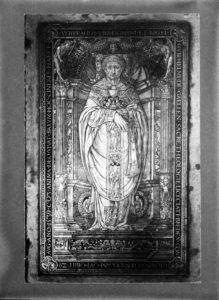
Fig. 2. Brass with the engraved effigy of priest Willem van Galen († 1539), dean of the Grote Kerk in Breda, see MeMO memorial object ID 2849
The floor slabs are stone slabs that correspond more or less to the height and width of a human being. Considerably larger slabs do exist, as well as much smaller ones, such as the stones that are mentioned in documents from Oudewater as ‘hooftstuck’ (‘head piece’). This type also occurs elsewhere, see for example MeMO memorial object ID 1310 and MeMO memorial object ID 1313 in Noordwijk and Utrecht. It is unclear whether in all of these cases the stones were placed in the floor. Possibly smaller stones were placed vertically in churchyards and against walls.
The tomb monuments and floor slabs could also be fully or partially covered with brasses (actually made of a copper alloy) in which the human figures and/or skeletons, heraldry, texts and other decorations were engraved (fig. 2). In general both the stones and the brasses used to be much more colourful than they are now. Stone slabs could be (partially) painted or inlaid with another material, and the brasses were sometimes decorated with enamel or even silver. The clothing of effigies was sometimes decorated with (semi)precious stones, see fig. 9
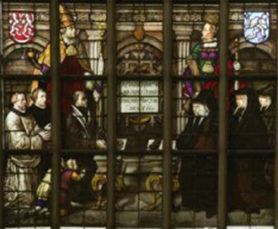
Fig. 3. Stained glass window in the Oude Kerk in Amsterdam with the devotional portraits of Jan Claasz. van Hoppen, mayor of Amsterdam († 1573), his wife and children, see MeMO memorial object ID 922
Memorial pieces (Memorialbilder)
Memorial pieces consist of religious images with devotional portraits of the persons to be commemorated, usually with their patrons saints, and with accompanying texts with the names and dates of death and a request for prayer, and – where applicable – their heraldry. In a religious image the commemorated persons could also be represented just by their names and heraldry, and even by their name saints as in the altarpiece of Antonis Pot and his family (see MeMO memorial object ID 496).
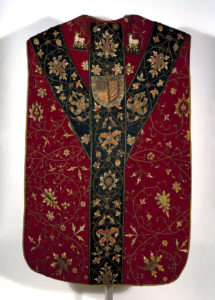
Fig. 4. Chasuble commemorating Berta de Vos van Steenwijck van Putten and her mother (1450-1500). A memorial text is embroidered around the heraldic shield, see MeMO memorial object ID 3893
There are memorial pieces that functioned as independent objects, such as:
- sculptures
- panel paintings
- stained glass windows (fig. 3)
- liturgical vestments of the priests and their assistants (fig. 4)
They were also present:
- in liturgical manuscripts and books of hours
- on liturgical vessels such as chalices and
- on furnishings in churches and other institutions
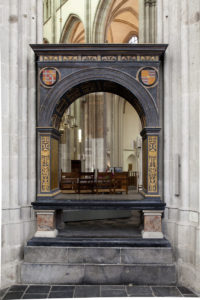
Fig. 5. Cenotaph of Joris van Egmond, bishop of Utrecht († 1559). He was buried in the Benedictine Abbey of St Amand, of which he was abbot, see MeMO memorial object ID 2956
Because the latter groups of memorial pieces have not yet been catalogued, only the independent memorial pieces have been included in MeMO. These independent memorial pieces were often placed in the churches, chapels and churchyards of parishes, monasteries, hospitals, etc., either on or near the grave of the commemorated persons or in a different location in the same institution. However, they could also be intended for another institution, which allowed the patrons to show their connection with multiple institutions, and also increased their chances of prayer for their souls. This was one of the reasons why the hearts, viscera and bodies of secular and religious dignitaries were often buried in different institutions (fig. 5).
The following table provides an overview of the terminology used in the MeMO database and supporting products for tomb monuments, floor slabs and memorial pieces.
| Term | Explanation |
| General | |
| Commemorative marker | An umbrella term for all memorial items that were intended to indicate a grave. In the MeMO database and supporting products, however, the term is used for a specific group of these, i.e. the crosses, the wall memorials and the engraved/painted memorial texts. |
| Memorial item | Object with a commemorative purpose |
|
Types of tomb monuments |
|
| Chest tomb or altar tomb | A monument consisting of a tomb chest, with or without an effigy on the tomb cover.
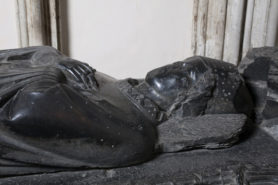 Fig. 9. Detail of the effigy of the Utrecht bishop Guy van Avesnes († 1317), see MeMO memorial object ID 2941 See fig. 9. Note that in this monument type the body is buried under the monument. |
| Cross | Usually a grave marker in churchyards, made of wood or stone, with or without an inscription, and sometimes with heraldry. See MeMO memorial object ID 1628. |
| Double-decker monument | A particular type of a two-tier tomb (see below) showing an effigy of the deceased on the upper level and a corpse or cadaver figure below. See MeMO memorial object ID 2251. |
| Floor slab | Stone monolith slab of varying sizes used to cover an intramural grave, i.e. burial under the church floor with the slab lying flush with the surrounding floor. See also Tomb slab. |
| Freestanding tomb monument | A monument physically detached from the surrounding architecture, often situated prominently before an altar. See MeMO memorial object ID 2972. However, such a monument may have been moved against a wall or into a niche or recess at a later date: see MeMO memorial object ID 1210. |
| Memorial brass | An engraved copper alloy plate usually sunk into a stone slab and affixed with metal rivets; varying in size, it may feature an inscription, heraldry, and an effigy of the deceased. Many such brasses have disappeared over time, leaving only an indent and sometimes the rivets with which the plates were fastened to the stone. See fig. 2 but also MeMO memorial object ID 1090. |
| Painted burial cyst | A small intramural burial vault, usually made of brick, with its plastered inner walls decorated with painted scenes, especially of a religious nature; known in Dutch by the term ‘grafkeldertje’ (French: ‘caveau peint’). Found in e.g. Aardenburg and Utrecht See MeMO memorial object ID 3277. |
| Recess tomb | A monument comprising a tomb (chest), placed inside a niche or recess in a wall. See MeMO memorial object ID 2959. |
| Sarcophagus | Monolithic stone coffin with a tapered lid, which may feature painted or sculpted decoration or an inscription. See MeMO memorial object ID 2565. A sarcophagus may consist of a plain coffin and a decorated lid. Often only the latter survives: see MeMO memorial object ID 2342. |
| Tomb slab | Stone monolith slab used to cover a tomb chest or a raised grave. It can be difficult to distinguish between a tomb slab and a floor slab, as subsequent alterations may have resulted in the loss of the tomb chest itself and the placement of the tomb slab directly onto or inserted into the floor. See MeMO memorial object ID 414 and ID 449. |
| Two-tier tomb | A monument consisting of an upper and lower tier, e.g. two platforms that may each feature an effigy or other commemorative object, such as armour. See MeMO memorial object ID 2970. |
| Wall tomb | A monument comprising a tomb (chest), placed against (or partly inserted into) a wall. See MeMO memorial object ID 3522. |
|
Memorial pieces |
Memorial image, Memorialbild |
| Diptych | A painted or sculpted memorial piece consisting of two wings. See MeMO memorial object ID 719. |
| Memorial painting | A painted memorial piece on panel, canvas, glass or a wall. See the Beesd van Heemskerk memorial painting (MeMO memorial object ID 504) and fig. 3 |
| Memorial piece | Memorial pieces consisting of religious images (usually present), with devotional portraits of the persons to be commemorated, usually with their patrons saints, and with accompanying texts with the names and dates of death and a request for prayer, and – where applicable – their heraldry. In the Netherlands there are memorial paintings in which the main image consists of the devotional portraits. |
| Memorial sculpture | A sculpted or engraved memorial piece of wood, stone or metal. See MeMO memorial object ID 492, ID 503 and ID 925. |
| Polyptych | Generally painted or sculpted artworks that consist of more than one piece, with one or more wings. However, in the MeMO database, websites and PDFs polyptych is used for artworks consisting of a middle part with more than two wings. See MeMO memorial object ID 677 |
| Separate memorial text |
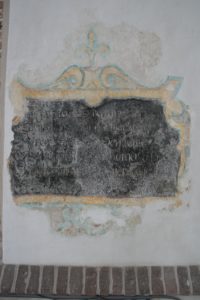 Fig. 6. Memorial text of Wybrant Saeckles (†1569) in Workum, see MeMO memorial object ID 3418 An engraved or painted commemorative text, usually on a pillar, a wall or on a stone tablet which is fixed to a wall. Originally probably not part of a larger memorial piece. See fig. 6.
|
| Single piece | Artwork consisting of one part, without any wings. See MeMO memorial object ID 524 and 843 |
| Succession series | Series of portraits or heraldry of successive secular or religious officials, or of the heirs of a family. See MeMO memorial object ID 748. |
| Triptych | Artwork consisting of a central part with two wings. See MeMO memorial object ID 516 |
| Wall memorial | A stone object attached to a wall, designed to commemorate a person or group of persons, usually consisting of a commemorative text with heraldry and a decorative surround. See MeMO memorial object ID 1385 |
|
Features |
|
| Cadaver | A depiction of the deceased as a (shrouded) corpse or skeleton to emphasise the transitoriness of the body, either sculpted in the round or engraved on a flat surface; also known as a transi. MeMO memorial object ID 281. (A cadaver may also be a personification of Death or a generic emblem of mortality, see MeMO memorial object ID 2251.) |
| Devotional portrait | A portrait of a person presented in an attitude of prayer, i.e. kneeling and/or with hands held in prayer. See the Beesd van Heemskerk memorial painting(MeMO memorial object ID 504) |
| Effigy | A portrait of a deceased person as part of a tomb monument or slab, usually sculpted or engraved, and often shown as a recumbent figure; also known as a gisant. See MeMO memorial object ID 1291 |
| Epitaph | The word epitaph already occurs in the Middle Ages for memorial pieces and is as such used in other European languages (cf. German ‘Epitaf’) both memorial pieces and the commemorative texts on a monument, but it is more strictly used in English to describe the commemorative text. In the MeMO database and supporting products ‘epitaph’ is used for commemorative texts only. |
| Gisant | A recumbent figure of a deceased person as part of a tomb monument or slab, usually sculpted or engraved (fig. 1), see Effigy |
| Heraldry: heraldic shield, coat of arms | The term heraldic shield is used for just a shield; the term coat of arms for a shield with exterior ornaments, such as a helmet, crest and supporters. The various shapes of the shields listed in the MeMO database can be found in this drawing. |
| Palimpsest | Current in manuscript studies to describe a re-used page, the term is also applied to re-used brass plates and stone slabs that have been turned over and engraved anew. |
| Pleurant or weeper | Strictly used to describe the figures of mourners on a tomb chest; not to be confused with bedesmen (i.e. praying clerics) that one may find at the feet of effigies on (English) tombs, or with the smaller subsidiary figures of offspring and/or relatives that one may find accompanying the life-size effigies of the deceased. |
| Tapered slab | A stone slab that gradually decreases in width; its shape frequently indicates that it is a sarcophagus lid, MeMO memorial object ID 1411. |

